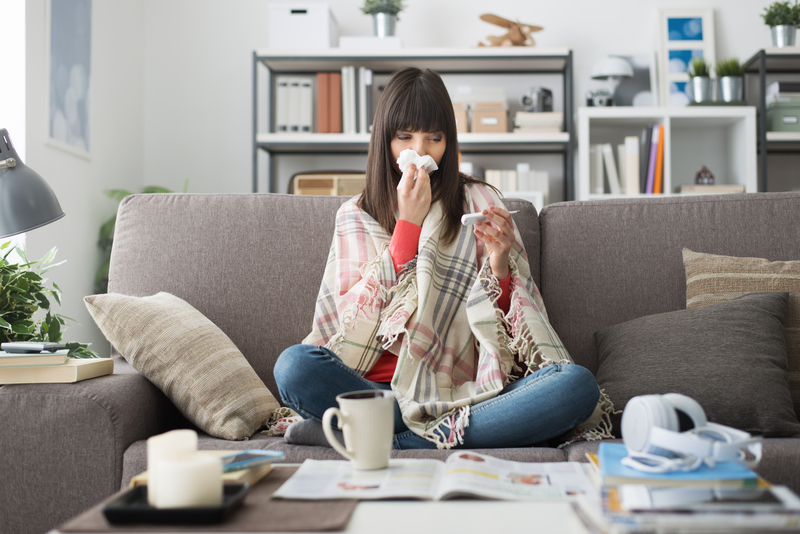Is Your Home Making You Sick? See the Warning Signs

Home sweet home. Your home is your sanctuary. It’s the place your stuff lives. It’s where you can deeply connect with family, friends, pets, and even yourself. And it’s where the average person spends around 65% of their time. With all the benefits of a home of your own, you may wonder why you don’t feel as good as you could or should when you’re there. Is your home making you sick?
You likely go home to relax and rejuvenate. It’s supposed to be where you can prepare for whatever life throws your way, but if your home has hidden toxins, it can do the exact opposite. While symptoms of an unhealthy home can vary dramatically from person to person, they can include:
- Throat irritation
- Chronic coughing
- Difficulty breathing
- Chest tightness
- Sneezing or a runny or burning nose
- Dry, itchy skin
- Rashes
- Headaches
- Dizziness
- Brain fog (including difficulty concentrating or forgetfulness)
- Tiredness
- Irritability
- Mood swings
- Light sensitivity
- Nausea
- Body aches and pains and stiffness
- Worsening symptoms from a current illness
Here are the warning signs that your home is making you sick and what to do to help you create a home that nurtures your body and mind!
6 Warning Signs Your Home Is Making You Sick
1. It’s Humid
If your home harbors humidity of 45% or more, you may be living in the perfect breeding ground for mold. This is great for mold spores, but it’s not so good for you as certain types of mold can cause a wide range of health issues, such as chronic sinusitis, infections, and even nervous system damage. 1
Mold is a type of fungus that starts to cultivate from the tiniest spores floating through the air. All it needs to grow is a damp spot. In other words, mold is already everywhere, especially in bathrooms and kitchens. Yes, even the cleanest homes have some mold.
Not every type of mold is problematic. And some people are much more sensitive to various molds than others. Yet if you’re the type of person who seems to always have a sore throat, cough, stuffy nose (i.e., cold-like symptoms), headaches, fatigue, dizziness, or nausea, then you may be more sensitive. And people who have a chronic lung condition (even asthma or seasonal allergies) or a weakened immune system should be particularly careful.
If you are experiencing issues with mold, it may not be enough to just wipe down the surface areas. (Mold can hide behind walls and cabinets and in ductwork.) However, surface areas are the best place to start. In other words, if you can see or smell mildew or mold, remove it. You’ll also want to fix any water leaks or any other areas where water accumulates.
You know how little droplets of water form on the windows when it’s cooler and drier outside than inside? That’s condensation, and it is another source of water many people don’t think about. That water can drip down into window seals and get into walls. And if it doesn’t dry out, again, it can lead to mold growth.
After fixing any leaks or places where water is coming in, if the moldy area is under 3 feet by 3 feet, you can likely clean it up yourself. Wear old clothes, an N-95 or P-100 respirator, protective eyewear, and gloves. Spray the area with white distilled vinegar and/or hydrogen peroxide and let it sit for an hour or more. If you need to scrub the mold away, you can use a baking soda solution. Then rinse with clean, warm water and allow it to dry completely. 2 And if you have a larger area, it may be time to call in the pros.
Humid environments also invite dust mites, which have been shown to cause allergies, stomach problems, and even disrupt sleep.
If you don’t know how humid your house is but suspect it may be an issue, you can purchase a humidity monitor. If it measures above 45%, here are some things you can do to lower the humidity:
- Run fan vents when cooking and bathing
- At dryer times of the season, open up the windows for some fresh air
- Purchase a dehumidifier or stop using a humidifier
To remain comfortable, while decreasing the chances of developing mold, try to keep the indoor humidity between 35 and 45%.
2. It’s Dusty
Of course, it’s impossible to have a dust-free environment unless you have an extensive (and expensive) professional clean-room situation. However, dust isn’t just a cosmetic problem. With it comes dust mites, which can get into the eyes and nasal passage, triggering inflammation and stressing and even weakening the immune system. 3 Plus, dust and dirt from outside can also unknowingly expose us to pesticides, herbicides, and other potential toxins.
To reduce the dust in your home:
- Vacuum regularly and ensure the filter on your vacuum is routinely cleaned and that you’re emptying the vacuum cleaner contents as soon as possible after vacuuming. Don’t forget to vacuum the often-forgotten areas like under the bed or couch or on the top of hard to reach places
- Use a HEPA filter with your heating and air conditioning to minimize the spread of dust
- Dump your shoes when you get into the house or at least use a doormat—and help your animals by wiping off their paws
- Regularly wash the fabric in your home, such as bedding, curtains, and even stuffed toys
- Have your air ducts professionally cleaned at least every two years
3. You Have Water Damage
Perhaps your roof leaked, the water heater broke, a window was leaky or left open, or the basement flooded. If that happens when you’re not at home (or you don’t know it’s happening) and the water isn’t cleaned up quickly and properly, you could be setting up your home for mold—even if you live in a drier climate.
Watch for water damage in your home, which can appear as:
- Peeling, cracked, discolored paint on the walls or ceiling
- Softened or warped drywall or floors
- Bulging trim that’s not flush against the wall
- Mildew or mold in our around your washing machine—especially if you have one that’s front-loading
Your first step is to fix the source of the water damage. Then clean thoroughly (as explained in the section on humidity). Watch for further damage, especially in basements or near windows or if there’s been a leak in the ceiling. And make sure your gutters and downspouts are directing any rainwater (or melting snow) away from your home.
4. Your House Can’t Breathe
You may be so vigilant against any water coming in or keeping the cold winter/hot summer air outside of the house that you seal everything completely. That’s great for energy efficiency, saving on heating and cooling bills, and even cutting back on dust, but it can also lead to health problems.
This is because the air in our homes can also have toxins—from the air we exhale, our appliances (especially gas), Radon gas (from floor drains or cracks in the foundation), and off-gassing from furniture, carpeting, and plastics. It’s essential to ensure our homes are ventilated to protect the air quality. This can be done naturally (via open windows) or mechanically (via air to air exchanges and filters on the furnace or air conditioner).
To help your home breathe (and decrease toxins):
- Open windows and doors when you can
- Install mechanical ventilation for your heating and cooling exchange
- Make use of fan vents when cooking or bathing
- Change out your air filters regularly
5. The Lighting Is Bad
If your lights are old and flickering or just not bright enough, or if you are using an old, outdated computer display, your house might be making you sick due to eye strain.
Improve the lighting by:
- Replacing old, outdated lightbulbs, especially fluorescent lights or those that flicker—new LED lighting can provide more natural lighting that’s easier on the eyes and saves you serious cash to boot
- Replacing outdated monitors
- Regularly giving your eyes a break when working on the computer or watching TV by looking out into the distance
- Opening up the curtains to let natural daylight in when possible
6. Your Air Is Toxic
Even if your house can breathe, your home might be making you sick if you’re being exposed to regular toxins like:
- Tobacco smoke or vape
- Formaldehyde (often from wood furniture and floors)
- Asbestos
- Cleaning product chemicals and fragrances
- Pesticides
- Carbon monoxide
- Ozone from printers
- Animal or insect droppings
How to Make Your House Healthier

To help clean up the air, make sure you’re:
- Using low-fume, no-fragrance cleaning products—if you’ve been using chemical-based air fresheners or synthetic fragrances, now’s the time to stop
- If you have cleaning or home repair chemicals, store them away from pets and kids, preferably away from the house, especially living areas, if possible
- Changing out those air filters
- Balancing humidity levels to around 45%
- Taking regular breaks outside when possible
- Opening up windows and doors when possible
- Using caution if you do use indoor chemicals
- Keeping your furnace and chimney clean and maintained every year and ensuring they’re appropriately vented
- Purifying your air with plants—some of the best (safe for kids and pets) plants to keep in your home include:
- Aloe
- Areca palms
- Bamboo palms
- Boston ferns
- Broadleaf lady palms
- Dwarf date palms
- Gerbera daisies
- Lilyturfs
- Moth orchids
- Spider plants 4
- Circulating the air with ceiling or room fans
- Washing your bedding regularly (at least weekly) with hot water to help fight off dust mites. Then ensuring they’re completely dry before they go back on the bed
- Store food in tight containers and clean up any spills to reduce insect and other pest contamination
Is Your Home Making You Sick? A Wrap-Up
Home is where the heart is and where you probably spend most of your time, so it’s worth it to seek out any issues that could be making you sick and correcting them as soon as possible. It can be challenging and even overwhelming, so start where you are and with the most obvious problem areas. If you see a leak, fix it, for example. And then add routines to help keep your home clean and you and your family as healthy as possible.




 7 Signs Your Body is Seriously Low on Collagen (not just wrinkles)
7 Signs Your Body is Seriously Low on Collagen (not just wrinkles) Health Expert: "Turmeric Doesn't Work (unless...)"
Health Expert: "Turmeric Doesn't Work (unless...)" 3 Warning Signs Your Probiotic Supplement is a Total Waste
3 Warning Signs Your Probiotic Supplement is a Total Waste

